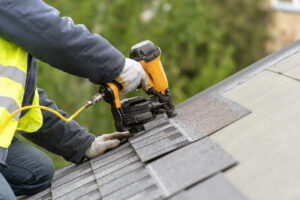Best Roofing Materials for Hot Dry Climates: A Utah Homeowner’s Guide
Utah’s climate is no joke. With scorching summers, low humidity, and nearly 300 days of sun each year in many areas, choosing the best roofing materials for hot dry climates isn’t just smart—it’s essential. A roof that performs well in our region can help protect your home from UV damage, keep cooling costs down, and extend the overall life of your investment.
Whether you’re building new or considering a roof replacement, this guide will help you evaluate your options and make an informed decision that pays off for decades.
Why Climate Matters in Roofing
Roofing materials react differently depending on environmental stressors. In hot, dry climates like Utah’s, your roof must stand up to:
- High UV radiation
- Intense heat waves
- Sudden temperature shifts between day and night
- Minimal rainfall with occasional windstorms
Top Roofing Materials for Hot, Dry Regions
Below is a breakdown of popular roofing materials and how they perform in Utah’s desert-like climate.
| Roofing Material | Lifespan | Heat Resistance | Energy Efficiency | Maintenance Needs |
|---|---|---|---|---|
| Asphalt Shingles | 15–25 years | Moderate | Low–Moderate | Low |
| Metal Roofing | 40–70 years | High | High | Low |
| Clay or Concrete Tile | 50–100 years | Excellent | High | Moderate |
| Synthetic/Composite | 30–50 years | High | High | Low |
| Slate (Natural Stone) | 75–150 years | Excellent | High | High |
Let’s break down the pros and cons of each to help you determine the best roofing materials for hot dry climates in your situation.
1. Asphalt Shingles

While asphalt shingles are the most common roofing material across the U.S., they are not the best fit for extremely hot climates. Utah’s dry heat can cause shingles to dry out, crack, and lose granules much faster.
Pros:
- Budget-friendly
- Easy installation
- Readily available
Cons:
- Degrades quickly in extreme heat
- Lower energy efficiency
- Shorter lifespan compared to other materials
Best For: Budget-conscious homeowners who plan to replace their roof again within 20 years.
2. Metal Roofing
Metal roofs are becoming a top choice in Utah thanks to their durability and ability to reflect sunlight. They’re ideal if you’re looking for a long-lasting, energy-efficient option.
Pros:
- Reflects heat, reducing cooling costs
- Resistant to cracking and warping
- Fire-resistant
Cons:
- Higher upfront cost
- Noisier during storms unless properly insulated
Best For: Homeowners who want longevity and energy savings without much maintenance.
3. Clay or Concrete Tile
These tile roofs are especially popular in southwestern-style homes and do exceptionally well in hot, dry climates.
Pros:
- Excellent thermal performance
- Long lifespan
- Low flammability
Cons:
- Heavy (may require structural reinforcement)
- More expensive installation
- Fragile under heavy impact (hail, fallen branches)
Best For: Homes with the structure to support the weight and owners looking for aesthetics and performance.
4. Synthetic/Composite Roofing
Made to mimic slate or wood shakes, synthetic materials are designed to withstand UV exposure, high heat, and impact.
Pros:
- Lightweight and durable
- Cool roof options available
- Resistant to mold, mildew, and fading
Cons:
- Varies widely in quality between manufacturers
- Can be costly upfront
Best For: Homeowners wanting modern solutions that combine performance, aesthetics, and sustainability.
5. Natural Slate
While not common due to cost, slate roofing is one of the most durable and fire-resistant options on the market.
Pros:
- Extremely long lifespan
- Natural insulation properties
- Adds luxury appeal
Cons:
- Very expensive
- Heavy
- Complex installation
Best For: High-end homes where budget is less of a concern.
What Makes a Material Great for Utah’s Climate?
To qualify as one of the best roofing materials for hot dry climates, a roofing product should offer:
- UV Resistance: Materials should resist degradation from constant sun exposure.
- Cool Roof Rating: Reflective coatings or materials that deflect sunlight lower roof surface temperature.
- Durability: Withstand rapid temperature shifts and dry conditions without cracking or losing structural integrity.
- Low Maintenance: Materials that require fewer repairs in a dry climate save time and money.
Energy Savings and Heat Reflection Matter
Choosing the right material doesn’t just extend your roof’s life—it saves you money every month. Studies show that reflective roofing materials can reduce roof surface temperature by up to 50°F, translating to up to 15% savings on summer cooling costs.
FAQs: Best Roofing Materials for Hot Dry Climates
Q: What is the longest-lasting roof for hot dry climates?
A: Natural slate and tile roofs tend to last the longest—50 to 150 years—but synthetic and metal options also offer great durability with lower weight.
Q: Are metal roofs too hot for Utah homes?
A: No. In fact, metal roofs reflect sunlight and release heat more efficiently than asphalt, keeping your home cooler if installed with proper insulation.
Q: Should I replace my asphalt roof sooner in Utah’s climate?
A: Yes. Asphalt shingles typically wear out faster in hot, dry conditions, so it’s smart to monitor them closely and consider early replacement.
Q: What is a “cool roof” and do I need one?
A: A cool roof is made from materials that reflect more sunlight and absorb less heat. In Utah’s climate, a cool roof can significantly reduce your cooling bills.
The best roofing materials for hot dry climates combine durability, reflectivity, and structural integrity. Whether you choose metal, tile, or synthetic, A1 Roofing is here to help you make the right investment. Our expert team specializes in full roof replacements that are built to beat the Utah heat and last for decades.
Ready to upgrade your roof?![]()
Contact A1 Roofing today for a free consultation and let’s find the perfect material for your home and climate.
